Posts Tagged Television
Why Bunnicula Is One of 2016’s Best Animated Debuts
Posted by kjohnson1585 in Animation, Television, Uncategorized, Writing on April 12, 2017
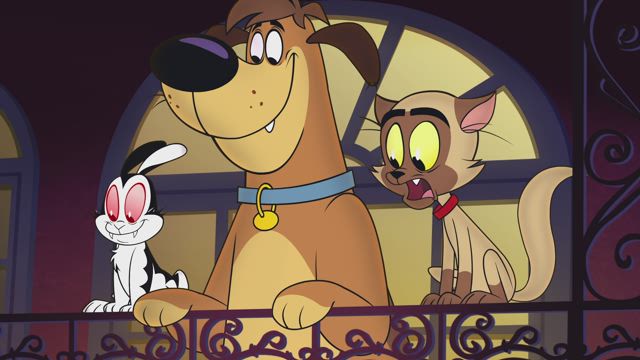
In 2016, Cartoon Network attempted to rebrand Boomerang, its sister channel that airs an assortment of classic cartoons and nostalgic ’90s productions. Along with the newly-fashioned logo, Boomerang broadcasted three new shows: Be Cool, Scooby-Doo, Wabbit, and Bunnicula. Be Cool, Scooby-Doo, which I reviewed here, was clearly meant to be the flagship show to capture new viewers for the “new” channel. Scooby-Doo fans are a quiet but dedicated bunch, and their eyeballs would help steer the channel in positive direction. Wabbit, the newest iteration of the Looney Tunes franchise, was essentially the version of what The Looney Tunes Show was originally meant to be. Its use of classic characters and short-length format would fit perfectly between old and new shows, and meant to appeal to those (dwindling) fans as well. Then there was Bunnicula – a curious show based on the classic book series of the same name. There wasn’t much of a big push for this show, certainly not in a way that would scream “check out the new Boomerang!” It’s hard to say what role Bunnicula was supposed to be in the overall rebrand, but it’s clear it wasn’t supported but CN bigwigs.
The rebrand was, for all intents and purposes, a failure. Be Cool, Scooby-Doo brought in its fans but they weren’t sitting around for the overall Boomerang change-over. Wabbit struggled to grasp the kind of manic energy that the best Looney Tunes works could muster; its skinny designs and muted color palette didn’t help much either. And, again, there was Bunnicula. The off-kilter cartoon by Jessica Borutski and Maxwell Atoms had a less-than-average pilot and made an strange choice in casting Sean Austin to voice Chester and Chris Kattan to voice Bunnicula – the latter of whom barely speaks any actual words. Using non-typical voice actors to voice cartoon characters is a fairly dangerous move, and that pilot suggested some basic, cartoonish antics – Tom & Jerry-level slapstick within a soft-horror atmosphere. Nothing suggested it was worth watching, in other words. But it’s now clear that this was all set-up. Bunnicula quietly uses its pilot and subsequent episodes to build a genuinely creepy and funny show that manages to depict three specifically-cliched characters with layers of complexity that become more and more noticeable over the series’ run.
[As part of a sudden new approach to Boomerang, a number of episodes have been placed on its online streaming site, which requires a paid subscription. Time will tell if this will be more effective than their cable rebrand attempt.]
It’s common for characters in cartoons to exhibit various stock traits that are utilized to incite conflicts that lead to comedic set pieces or low-key dramatic beats. The story usually take precedent, in which characters’ personalities and behaviors butt up against other characters’ personalities and behaviors, or some broadly ludicrous situation. The sillier the cartoon, the more exaggerated those traits will be. Traits may be slightly adjusted as episodes go along, but there’s rarely much examination on why certain characters are the way they are. The nerd kid is the nerd kid. The spunky gal will always be the spunky gal. The stupid goofball is, unfortunately, the stupid goofball, day in and day out. Bunnicula is different. It definitely exhibits the exaggerated energy of a silly cartoon, but it puts more careful consideration into its characters (particularly Chester and Bunnicula, but Harold as well) than you might expect. Bunnicula, on the surface, is about a scaredy-cat, a dumb dog, and a carefree demon bunny getting involved with wacky situations. Bubbling underneath is the story of a family of pets with strong, personal, problematic traits that they gradually work through so as to try and be there for not only each other, but for their owner as well.
Bunnicula is a far cry from its original source. They’re not old-hat pets owned by a boy and his family, but semi-new pets procured by a young, tomboy-ish girl named Mina and her father. Chester, Harold, and Bunnicula know each other of sorts, but it feels like they’re still getting the hang of being around each other, and around Mina. They clearly love her, but they’re working through the particulars of what that entails, particularly Bunnicula. They’re also working through how they exactly feel about each other, as their comic traits are used to mask or distract from their truer feelings for each other. All of this takes place within a New Orleans locale (an inspired setting to be sure), filled with various kid-friendly (but still creepy) horrors and monsters. Yet in the midst of all that, these three pets seem to grow… well, if not more fond of each other, at least more understanding of each other and themselves. They incrementally discover that their base traits are something that they need to work on and work through – not just specific traits for the comedic sake of it. (Even in the chaos of the pilot, “Mumkey Business,” it’s clear that Bunnicula expresses a slight change of heart towards Mina, upon realizing his causal associations with dangerous creatures could harm her.)
Bunnicula, at the base level, thrives on an old-school cartoon charm and sensibility. Molded off the basic premises of Hanna-Barbara cartoons (particularly Tom & Jerry), Bunnicula visually and narratively exhibits an artistic design that would be at home in the ’40s and ’50s. Harold is a clear homage to Scooby-Doo himself. The characters’ hands can transform from animal paws to actual gripping fingers in an instant. Characters pull items out of nowhere from behind their backs and possess pockets in their fur whenever they need them. Physical, violent humor is the norm, if not as extreme as those classic shorts were. It’s righteously self-aware. Chester, Harold, and Bunnicula function on a single trait that instigates, or mitigates, the plot. It does Wabbit better than Wabbit does Wabbit.
Yet unlike most classic shorts, its three leads are driven, at a base level, by genuine love. It’s probably the first cartoon of its type where characters actually say the words “I love you” to each other, even if after the stress of a crazy story. It’s a show where its cast deeply care about each other, even if they have to be reminded of it. Their endgame protection of Mina from the disturbing creatures around them keeps them successfully grounded, even when their intrinsic traits push them to their extremes. Bunnicula himself is wildly amused by these horrible creatures, but needs to reminded of their danger to Mina (and by proxy, Chester and Harold). Eventually, he calms down. Harold is less complex – a simple dog who often gets the buffoonish jokes, but he also is more emotionally open and honest. He’s the first one to express love for others and to whom Bunnicula and Chester most likely express their affections. (This is most notable in the episode entitled “Bearshee,” where Harold plays diplomat between the easily scared cat and a confused, frightened ursine specter.)
Then there’s Chester.
Using Sean Austin as the voice for Chester in retrospect was a good idea. Austin captures that over-the-top energy that’s often required from the character, but he also manages to nail a sad vulnerability in the character that becomes clearer in each episode. Chester’s fears are both exaggerated and sensible, but also weirdly indicative of something, perhaps, darker and lonely. (Nothing exemplifies this more than his final speech in “Chester’s Shop of Horrors.”) He often desires to be a human (“Curse of the Weredude,” “Nevermoar”), for example, and it’s tricky to tell if it’s just to escape being a cat, escape being afraid all the time, or to be respected for his “true” self. (Arguably, it’s all three.) He desires the simple, finer things: a good crossword puzzle, beat poetry, riddles, sci-fi. He’s also kind of a control freak, but it’s not driven by an inflated sense of self-worth – not entirely. It’s really to have some sense of control over his own life, in a world of random terrors and horrors that come to afflict him and his world (darkly captured at the end of “Puzzle Madness”). At times he will go overboard, torturing Bunnicula or deeply believing he deserves good luck at the expense of others’ bad luck. Chester’s fears and insecurities aren’t wrong, His reactions to them often are, but also, he can’t help it.
Chester, Bunnicula, and Harold are who they are, and Bunnicula takes care (for the most part) to make sure their actions and attitudes make sense, that even when they butt up against each other, that it’s all part of a “larger” struggle to find common cause or affection among each other. Bunnicula shows that that kind of emotional camaraderie is a hard thing to do. There’s no grand epiphany – partly because if there was, there’d be no show. But there is a gradual, tedious, comical struggle for the characters to accept each other, and their flaws, and their insanely divergent personalities. Bunnicula is about how love trumps all, even within the context of a wacky cartoon, but it also shows how tricky it is to let that love win out, especially towards those who represent things you don’t even stand for. There’s real affection between the characters, but it’s hard for them to see it, and the show somehow makes it fun to see them try.
Tip from Home: Adventures with Tip and Oh is the Young Black Female Lead We Need Right Now
Posted by kjohnson1585 in Animation, Television, Uncategorized, Writing on August 24, 2016
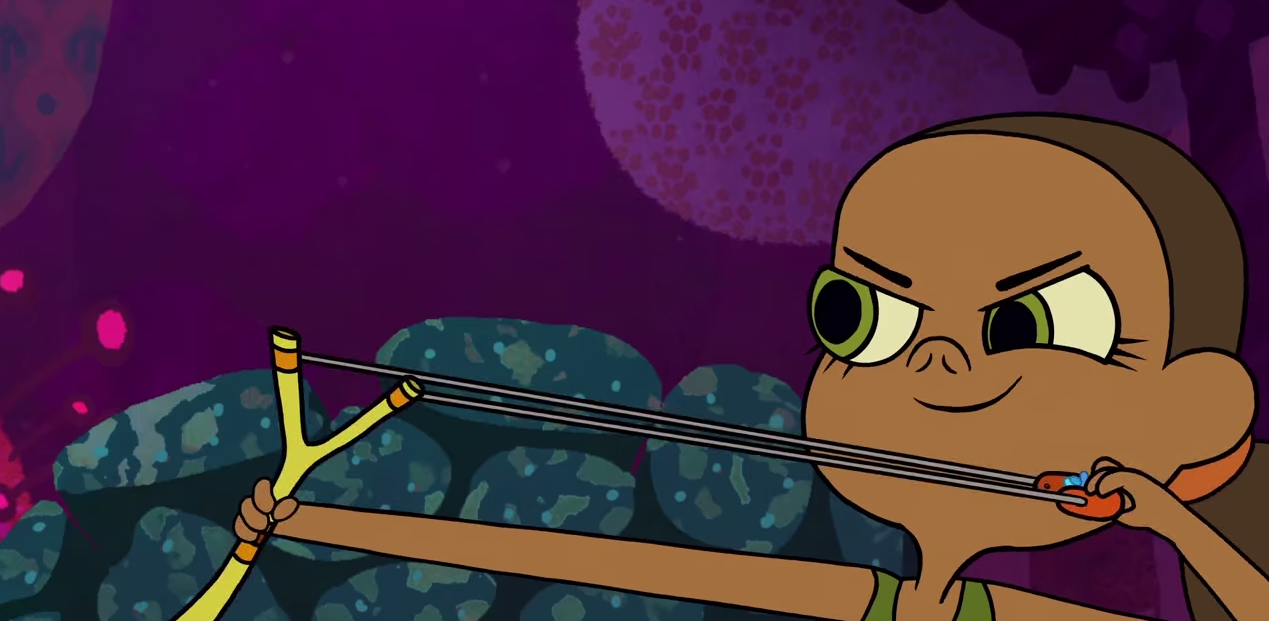
Home: Adventures with Tip and Oh is based on the Dreamworks film Home, a buggered, incomplete piece of animation that never quite grasped the satirical edge needed to portray the abject and complete removal of citizens into makeshift suburban prisons. Home cared little about the uncomfortable connotation of such a premise, which resulted in a plot – in which a young black girl teams up with an alien outcast to try and find her mother – that could not shake off its racially-coded baggage. I know. I know. I wish I could just ignore the analogies – the wholesale removal of people from their homes, the wholesale removal of African people from their continent, the constant splintering of slave parents from their children to foster an economic system that possesses ramifications that last even till this day. But what you need to understand is that it is so, so hard, and Home did little to ease that discomfort from my mind.
In that regard, I had very few expectations of this show.
If a Home TV series had to be made, the best bet would be to ignore that entire premise and forge onward with new, unrelated storylines. Adventures of Tip and Oh does for the most part, although the occasional exploration of the Bov’s cinematic past actions is as awkward as you’d expect (more on that later). The animation is decent; the character designs are off-putting, as typical of Thurop Van Orman’s style, but functions well enough in movement, and viewers will find themselves getting used to it fairly quickly. The character choices are fairly trope-y and questionable, with Donny being a Mr. Krabs-esque non-entity, Sherzod gearing up to be the most decisive character in a while, and Lucy exhibiting a certain level of air-headedness that doesn’t seem to fit a single mother living in Chicago. These, and other creative decisions, suggest the writers are still working through some issues, but there is one thing that Netflix’s new show has right: Tip herself.
I didn’t warm up to Gratuity “Tip” Tucci at first. She seemed a bit all over the place. She is inconsistent, a bit aggressive, a bit loud, a bit too weird – especially compared to her cinematic counterpart. But then I realized something: that is the point. Tip is purposely, uniquely, her own girl. She is an eighth-grader who possesses her own very limited, very vain, very specific point of view. Her aggressiveness, loudness, and weirdness is uniquely her own. The writing doesn’t quite do her any favors, specifically in terms of the situations that she finds herself (and Oh) in. But Tip herself is special. She is unabashedly herself, not particularly concerned to fit within the parameters of young girl character templates – specifically, young black girl characters – that came before her. She is Penny Pride – clever, determined, confident to a fault – mixed with Star Butterfly – extroverted, adventurous, out-of-her-league. Tip is confused, lost, conceited, goofy, and, yes, even grating. She is all those things – which makes her the best, most important young black female lead for children today.
I need to reiterate something: other than Doc McStuffins – a show for preschoolers – we do not have a single animated show on the air with a black girl as a lead. Mostly cartoons are driven by young boys (or talking animals). There are more shows now with girls as leads, and/or shows with strong feminine characters. But they’re mostly all white (save for Steven Universe’s Garnet, which is another matter entirely). And that is fine. But in this era and in the call for more diversity, it’s telling that, as usual, young black girls are continually, routinely ignored. (Full disclosure: I pitched this piece to a well-known site, which was rejected, and which I deeply believe contributes to this problem.) Seeing and experiencing someone like Tip on my screen felt revelatory. It made me realize how limited in scope my expectations of what young black girls could be. (Note I didn’t say “what black girls should be,” which is an extremely important distinction.) I love Tip because, sometimes, I don’t love Tip. I love that she’s sweet and loving and naive and annoying and too much and quirky and super-weird and sometimes “uppity.” Black girls need to see this. We all need to see this.
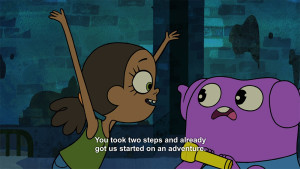
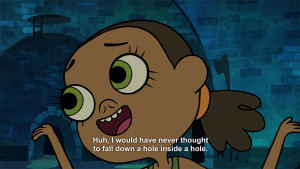
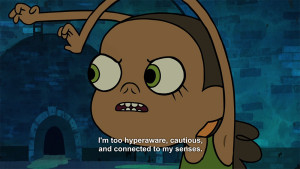
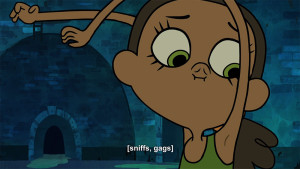
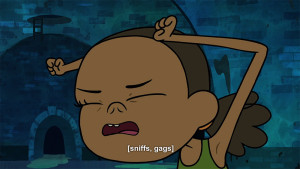
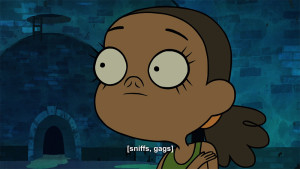
This scene epitomizes the kind of person Tip is as a character. There’s no contextual reason why she sniffs herself (they’re in a sewer, but there’s no reason why she sniffs her armpit versus any other part of her body), but it shows her her spirit, vanity, and goofiness all in one brief monologue.
Tip isn’t African-American. She’s Caribbean-American. Her grandparents immigrated from Barbados; Tip is second-generation. The show doesn’t play around too much with this, although it is nice to see when they do. (I would love to see more Barbados-inspired bits on occasion, in the fun ways that Sanjay & Craig sometimes played with its Indian-related bits.) I don’t expect the show to really do that, though, mainly because the writers don’t seem to really grasp the full relevancy of what they have in a character like Tip. There’s theoretically a lot to unpack in a show in which the Bov implemented forced displacement and occupancy, where the setting is Chicago, and where Tip and Lucy live by themselves sans a father figure. When Tip’s grandparents visit in “Wrinkly Humans People,” that awkwardness is palpable, but the writers don’t see it. After all, her grandparents deeply distrust the Bov for what they did, and you honestly can’t blame them. Yet the show works it so as to suggest that it’s her grandparents that are in the wrong, that they’re the ones who are, essentially, the bigots, since they just can’t get over what the Bov did. Well, of course they can’t. History is ugly.
Even still, there is potential here. There is a rich complexity in the idea of Tip’s broader acceptance of the Bov and, specifically, Oh, and how that comes up against the reality of what the Bov did. There is perhaps something to how easily a young Tip has forgiven the Bov in order to maintain the stability of her small family unit, and how that continues to push up against those still harboring resentment towards their occupiers-turned-neighbors. It would be deeply interesting to see episodes in which Tip has to, in some way, address how she justifies her love for Oh, as opposed to her past hatred for the Bov’s role in separating her from her mother. Adventures with Tip and Oh might have been better served ignoring all that overall, but although I do applaud the show for dipping its toe into the thornier sides of the film, I doubt the writers have the temperament to hit such dramatic notes.
That’s a dramatic layer way out of reach for this crew. At this point, in its first season, it would be just enough to take a fun, deep look at Tip herself (in the context of a young black eighth-grader with only a mother living in Chicago). As a unique character, the writers provide her with the variety of traits that I’ve mentioned earlier. As a character who will be developed, that where the writers fall short. It’s tricky, because the show doesn’t need to be an in-depth (if silly) examination on what it means to be a young black girl in Chicago – aliens or not. But it would be worth exploring some of the issues unique to that worldview and experience. The clearest example of this dilemma lies in “Angerdome,” an episode in which Tip deals with her anger. There are volumes of content that could be written that explores the social exploitation and discrimination that exists within the “angry black woman” trope. It is both vicious (which posits all black women as unstable and prone to violence) and commodified (from the lighter-but-overused “sassy” trope, to pushing their angry reactions on reality TV). It’s hard to say how the writers see all of this in “Angerdome,” though. There’s a moment, after various characters tell Tip to calm down, where she proclaims, “I’m allowed to be angry!” and it is wonderful; filled with the personal, determined, defiant spirit that young black girls need to hear. Yet the power of that statement is undercut when, immediately after, Tip resigns to needing help (and an outlet) to deal with her anger.
That’s what makes it hard. There is the real, distinctive lesson which allows kids to understand that having an outlet to deal with anger is important, and I can’t fault the show for dealing with that (although the answer they come up with is muddled). At the same time, the show mostly ignored the opportunity to explore Tip’s individual struggle with what it means to be a black girl who gets, and is allowed to be, angry. It’s a powerful statement that the writers fail to notice as a powerful statement. It’s part of the overall verve of the show, really. It’s great to see Adventures with Tip and Oh use a character like Tip to have fun with the general complexities of childhood, especially within such a specific premise. It’s tougher to see this done separate from the unique characteristics and history that Tip (and the show) embodies: the black, only-child, fatherless, Chicagoan setting. The universal ideas are fun, and pushing them through Tip is wonderful, but the writers have an opportunity to really explore Tip’s experiences at a personal, raw level, and I don’t think the writers see it – or they refuse to.
Still, I praise the fact that a character like Tip exists. She is simultaneously fun and frustrating, and it makes her necessary to see a character like her on television. What ever issues or concerns that may happen around the lives of the Tuccis (which, for all we know, could be fixed by season two), Tip’s goofy, abject, unforgiving weirdness and quirkiness – so often contributed to white women to the point of a dated, oft-misunderstood trope – has been finally applied to a young black girl. It’s just good, refreshing even, to see a black girl outside of a typical “no-nonsense” role. (Tip is no-nonsense, but it’s defined within her weirdness, not as a sole contrast to those “silly” white kids.) A lot of her appeal is due to the voice artist, Rachel Crow, a 2011 X-Factor contender taking the role from Rihanna from the movie. Rihanna had gumption, but at best her voice work was merely passable. Crow brings a serious, specific attitude to Tip – a rough energy that’s wonderfully infectious (in the same multi-layered cadences that the late Christine Cavanaugh gave to Gosalyn Mallard). She also has a distinct singing voice that manages to add flavor to both the show and the character, without it being too distracting or random.
So flaws and all, I look forward to see where Home: Adventures with Tip and Oh takes Oh and Tip in future stories. The creative critic in me wants to see the show lean a little harder on its premise, on its boundaries and issues, just to see them contextualize how Tip might respond to those tougher dilemmas and grow as a person. I would love to see those issues hit upon, to expose it to kids, particularly young black girls, who struggle through those issues every day. As for now though, I just want to see more Tip. I want to see more of her odd, assertive, annoying behavior. I want to be challenged, bothered, and amused by Tip’s antics, because I want young black girls – and all viewers, really – to understand that being like Tip is okay.
(Final note: I know this is “just a cartoon.” I know I should just enjoy it for what it is. What I’m telling you is, I just can’t. Not with what I know and experienced, not with what I’ve read, not with the history and context of this country and even Chicago itself inside my head, not with the news stories and the personal accounts of people’s experiences shared every single day. I physically, emotionally, psychological cannot separate the two. I can only channel it, and I would hope and love to see Home: Adventures with Tip and Oh do this as well.)
Zootopia’s Runaway Success, and the Disney Afternoon Connection
Posted by kjohnson1585 in Animation, Film, Television, Uncategorized, Writing on June 22, 2016

Alan Young passed away on may 19, 2016. To many, he was the lead farmer who could communicate with talking horses on Mr. Ed. To others, he was the perennial voice of Scrooge McDuck in Ducktales, the irascible richest duck in the world who led the way for one hundred episodes, one theatrical film, a number of classic and modern shorts, and even in the Nintendo reboot of the Capcom game. Young’s passing was memorialized by many of those who worked with him in TV, film, and gaming, yet in terms of the animation community at large, both creators and critics were mostly silent. It was a widely mute, seemingly moot passing: a death of the lead of what could arguably be the most important, game-changing cartoon in the last twenty-five years. Yet it’s representative of the general malaise, it seems, of the pop cultural response and respect to Disney’s 1980s-1990s animated output, which we could call The Disney Afternoon*.
I mention the Disney Afternoon for a reason. The kinds of cartoons that Disney produced – from the two cutsey-yet-complex starters The Wuzzles and The Adventures of Gummi Bears, to the TV show versions of Aladdin and The Lion King – really weren’t what we think of cartoons these days, or even what we thought of cartoons back then. In our current culture, we think of cartoons in sort of broad categories: wacky, silly, and childish; action and (super)heroic; adult and poignant; adult and absurd. Disney’s cartoons, however much they leaned into any of those categories, were anything but. At their core, the Disney Afternoon lineup were driven by adventure, specifically by strong, specific, and non-human characters who sought items, emblems, villains, and icons across multiple locales that thrived with an unique locality and ecology all its own. They were truly their own thing: the cuddly Gummi Bears with their thriving, complex society; the talented-yet-lazy ursine pilot with a surrogate son and a fussy-yet-determined boss; the team of rodents who actively sought to help others as they struggled to help themselves. Even as the quality of the shows varied throughout the years, the core nature of these shows thrived with exaggerated characters who were never-the-less grounded with real emotions, in worlds that only touched upon what could be possible in their unique, respective universes.
*******
There’s been a lot of shock and surprise over Zootopia’s runaway success, the only original animated Disney film to gross over a billion dollars globally since Frozen, and it’s been admittedly a bit frustrating to see how people both misinterpret the movie and/or downplay its proven success. I’ve seen a lot of explanations and theories that I’ve disagree with (the “night-howlers as crack” being particularly insidious), but what prompted me to write this was this fairly dismissive piece. Mr. Spiegel is a fine writer, but the impression I get is that instead of praising Zootopia’s success and offering a credible theory as to why it’s been a global box-office draw, he dismisses the billion-dollar revenue as a new normal, a “non-event.” Which is… pretty disingenuous. As of this point, only Marvel properties have hit the billion dollar mark on their own, as well as a handful of Disney properties (give or take a Minions, which success is couched more in its universality and less in its quality). Not only has Zootopia resonated with audiences across the world, it has incredible rave reviews; yet, at the same time, those reviewers, along with Spiegel, seem flabbergasted to place the film’s success in any context. Spiegel mentions how Zootopia lacks any real Disney World or Disneyland presence, which mainly speaks to Disney’s surprise that the film did so well, not to the “perplexing” nature of the film not gaining much cultural permeation (although I would argue it has, particularly on social media).
Spiegel’s confusion is understandable. The creators and directors of Zootopia often cite Robin Hood as the example in which the film draws its inspiration, and no one could argue that. Yet I feel like Zootopia also draws a tremendous amount of inspiration from The Disney Afternoon, shows often staring talking animals of a various sort in vibrant environments, shows that were also surprisingly deep and complex and meaningful in small ways. And these shows also lack cultural permanence as well. They are rarely showcased at Disney World or Disneyland. They are not quoted on social media or often gif’d or cited as inspiration by many of today’s current batch of animators (I have yet to see an interview with Byron Howard or Rich Moore that brought up TaleSpin as an inspiration, a show that might have well have taken place in 1920-Zootopia.) These are shows that are regularly taken down from Youtube and, until recently, only had (semi-incomplete) DVD releases. Zootopia’s lack of cultural permanence mimics that of the Disney Afternoon’s cultural permanence.
Yet I would argue that Zootopia’s success is exactly due to an audience that’s craving that kind of entertainment – films and/or TV shows driven by an adventurous spirit, led by non-human characters who feel grounded, real, and relatable, all within out-sized worlds that connect to our worlds in more ways than one. The aesthetics and atmosphere of Zootopia fit squarely within the aesthetics and atmospheres of the various Disney Afternoon cartoons: they may not match one-to-one, but they all possess similar criteria: strong, flawed, non-human characters; bursts of silliness mixed with raw, poignant moments; adventure-driven stories that far surpass the need for excessive silliness or wackiness; strong, detailed visuals and proportional character designs; clever uses of pop cultural references that neither stop the flow of the story or interrupt the proceedings for the easy gag. And even though the elements of both the film and the classic animated line-up seem absent from all social cachet, I think audiences are craving it. Viewers are way more open to the kind of entertainment they can find solace in as nerd spaces open up: Steven Universe and My Little Pony and the myriad of superhero films have expanded fanbases considerably. Back in the 90s, small but dedicated fans wanted to live in Gummi Glen, Saint Canard, or Cape Suzette**. Today’s audiences can add Zootopia to that list.
I believe this is what Dreamworks attempted to do in the 2000s. As the less-respected studio began netting large scale success with Kung Fu Panda and How to Train Your Dragon (another movie that seemed to have legs, financially), the studio sought to expand their visual worlds and rich characterizations onto the small screen. For a little while, it was a success, with Penguins of Madagascar a solid hit for Nickelodeon, which could be categorized as a wackier version of Rescue Rangers. Kung Fu Panda: Legends of Awesomeness was a solid follow-up, and Dreamworks followed that up with the Dragons series and Monsters vs. Aliens. But it became clear that Nickelodeon interference, combined with the limitations of the TV CGI landscape, deeply held things back. Nick never established a full Dreamworks block (Dragons went to CN, which promptly burned off the show, which was egregiously boring anyway). Kung Fu Panda, potentially closer to Darkwing Duck’s sensibility (a few writers wrote for both shows!), squandered its potential by leaning way too hard on its lead’s silliness instead of adequately building up its cast and its Valley of Peace locale. Monsters Vs. Aliens just wasn’t good. Given the deal between Dreamworks and Netflix soon after, Nick basically decided to cut its loses and moved on. (And no, the Dreamworks shows on Netflix have not quite matched the aesthetics of the Disney Afternoon.)
I’m not even sure it would have mattered. Dreamworks’ shows have yet to capture cultural permeation either. Except for perhaps Shrek memes, not a single show, either one Netflix or Nickelodeon, seems particularly discussed anywhere, despite the accepted fact that Dreamworks’ television decision is apparently still financially viable. All Hail King Julian has gotten the occasional note in the media, and most recently, Voltron has gotten the social landscape talking. All Hail King Julian sort of resembles Marsupilami, in that it’s focused on the antics of forest-based critters, but with bursts of cultural/social commentary that’s extremely hit or miss. (It actually functions better the rare times it focuses on its characters and pushes them in unique, new, personal directions, but it’s unfortunately pretty rare). And Volton, despite its high quality, doesn’t adhere to any of the Disney Afternoon aesthetics. The other various Netflix Dreamworks shows: Puss in Boots, Turbo FAST, Dragons (which moved from CN a few years ago), arguably do adhere to those aesthetics, but vary in quality and lacks cultural permeation. The former point really smothers up the latter.
It’s that point, which leaves Dreamworks’ programs scattered, random, and unregulated, that seems to allow Disney the opportunity to return to the Disney Afternoon glory. Not only is Disney rebooting Ducktales, but they also are working on TV shows based on Tangled and Big Hero 6. The latter two shows are human based, but, as they are based on some of Disney’s more successful animated films, they most resemble the 90s television takes on The Little Mermaid and Aladdin. I also don’t think it’s no coincidence that Ducktales, Rescue Rangers, and TaleSpin were recently released on iTunes, in their entirety (except for one lone Ducktales episode). In addition, there’s the new Darkwing Duck comic that’s happening. In mostly all those cases, these shows and announcements lack cultural permeation, but it would be a grave mistake to assume that means they lack an audience or a fanbase. Zootopia and its success is not an outlier, or an excuse to toss aside the significance of a global billion dollar draw. It’s an opportunity to examine the very content and context of Zootopia itself, and realize that the world is craving a very specific type of cartoon, one that died out so many years ago.
* to clarify, many of the early cartoons within the Disney Afternoon lineup were originally Saturday morning network-syndicated cartoons, before they were re-packaged as an after-school lineup in the 90s.
** the stylistic nature of the Disney Afternoon show could be a bit more malleable – Darkwing Duck and Bonkers were “wackier” than Ducktales, which itself was looser than TaleSpin – but even in all those cases, fully-realized characters and fully-realized worlds were still firmly established.

